Posts
-
Let's Read the 4e Monster Manual 3: Devil, Passion
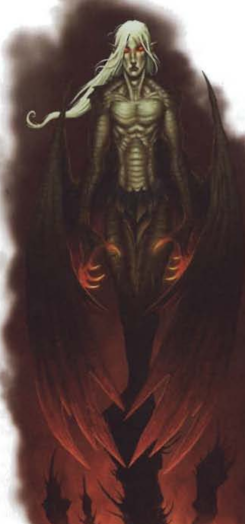
Copyright 2010 Wizards of the Coast This post is part of a series! Click here to see the others.
This is the first time I come across passion devils, but they give me strong 3e vibes.
The Lore
Do you want to employ seductive and manipulative devils in your villainous schemes, but feel that succubi are too nice? Fierna, archdevil ruler of Phlegethos, sure did! In order to fulfill her very specific needs, she created Passion Devils.
The reason these creatures give me a strong 3e-or-earlier vibe is that they feel like the sort of grid-filling exercise that was very common in those games. Succubi were considered demons back then, so when they needed to fill the “seductive manipulator” niche on the devil side they created a completely new creature.
In 4e, passion devils are kinda like a specialized succubus variant tied to Fierna. As incarnations of her vanity, they’re made in her image but always have some extra imperfection in their forms so their mistress remains the fairest of them all. They’re sent to infiltrate mortal societies just like a succubus, and they’re also used to replace the leadership of Fierna’s own cults so she can keep tabs on them. When used as official emissaries and ambassadors, they are often protected by a unit of bearded devil bodyguards.
The main difference between a baseline succubus and a passion devil is that the latter have serious anger management issues. When their tempers flare, their disguises tend to melt away as the passion devil abandons all subtlety and resorts to force. This is obviously what happens when the PCs thwart their plans, but it could also happen if they run out of patience while trying to employ standard succubus strategies. At least their fire powers make them better combatants than succubi when the jig is up.
The Numbers
These creatures are Medium Immortal Humanoids with the Devil keyword, and Level 16 Controllers. They have Darkvision, Resist Fire 20, and move at speed 6 on the ground or in the air. A pretty standard devil toolkit.
They project a charm aura (1) that makes others see them as a Object of Desire and take a -2 penalty to saves against dazing effects.
Their basic attack is a claw that targets Reflex and does fire damage. They can also be “gentler” and employ a Fiery Touch that does less damage and dominates for a turn. The ability that combos with their aura is Beckoning Whispers, a non-damaging attack against Will that pulls targets 5 squares and dazes them (save ends).
Finally they have an area attack named Passion’s Flames, a Close Burst 3 that deals fire damage and forces any dominated enemies it hits to make melee basic attacks against targets of the devil’s choice.
As a minor action, the passion devil can change shape to appear like a Medium humanoid. The DC to see through the disguise is a respectable 36, but it’s less stable than that of a succubus and ends when the devil attacks.
Final Impressions
It’s a Succubus Plus with a temper. Lore-wise they’re Fierna’s trademark servants, so they fit into any adventure where she’s the main enemy. Otherwise you might want to use leveled-up succubi from the Monster Vault, or reskin these into succubi as appropriate.
-
Let's Read the 4e Monster Manual 3: Devil, Hellwasp
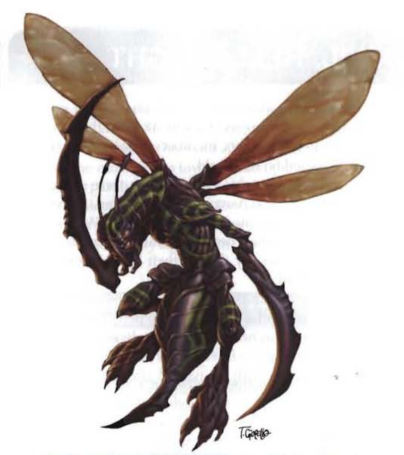
Copyright 2010 Wizards of the Coast This post is part of a series! Click here to see the others.
I don’t remember seeing hell wasps before, but they sound like the sort of monster that might have debuted in 3e.
The Lore
In past editions the Blood War was this eternal alignment-based conflict, but here it’s part of Asmodeus’ safety net. You see, the other gods don’t like Asmodeus very much, both because he’s an evil asshole and because he got his position by murdering a popular non-evil deity.
One of the measures he took to prevent them from ganging up on him was to commit the considerable armies of Hell to the task of containing the demons of the Abyss. As we mentioned before, demons are too busy with infighting to launch regular invasions on the rest of the universe, but when they do manage to briefly get their shit together and spill out, they find a few legions of devils waiting to fight them. Hell also launches occasional raids into the Abyss to prevent demons from organizing.
This isn’t a war that rages on eternally, but a series of sporadic conflicts that flare up whenever one of the two sides feels a bit stronger. The gods lets Asmodeus be because he provides a valuable service, and because providing that service also serves as a check on his power. Asmodeus and his underlings in the meantime keep enacting diabolic schemes to acquire more power in an attempt to dominate the other gods.
One of the most enthusiastic participants in the Blood Wars seems to be Glasya, Asmodeus’ daughter. Because of this she tends to be involved in stories where demons and devils switch sides, corresponding to her failures and successes. We already heard about Graz’zt the devil who became a demon lord. And now we get to hear about a whole species of demon who became devils.
Hellwasps were once a species of demon related to the insectile mezzodemons, servants of a wasp-like demon lord whose name was lost to time. Glasya fought and killed this demon in one of her raids, and its spawn immediately swore allegiance to her. She took the lot of them to Hell and converted them into devils. Now they inhabit the Garden of Delights, a region of Malbolge. As loyal servants of Glasya, they can be found alongside any of her other servants or allies.
The Numbers
Hellwasps are Medium Immortal Magical Beasts (devils). They have Darkvision and a Flight Speed of 8 (hover), but their ground speed of 0 means they can’t actually walk. They fight with their natural weapons: a pair of sword-like talons, and a huge venomous sting.
Hellwasp Colony Guard
This is a Level 19 Minion Skirmisher of the kind you can find by the score in hellwasp hives. Their Sword Talon attack allows them to shift 1 square before or after the attack, and their Sting deals poison damage, slows, and prevents the target from shifting for a turn.
They’re good for slowing the PCs down and setting them up to be surrounded by sturdier allies. The ability to shift away after a talon attack makes them slightly less vulnerable to melee-centric PCs.
Hellwasp Devil
The regular version is a Level 23 Skirmisher with 212 HP. Since it’s higher level it probably represents an exceptional individual within a hive, of the kind that gets loaned out to allies and sent on away missions.
Aside from a somewhat weak Sword Talon attack, the hellwasp can also perform a Talon Skewer. This also counts as a basic attack. It allows the wasp to fly its speed and make two talon attacks at any point along the movement. The wasp doesn’t draw opportunity attacks when moving away from the target of these attacks. If both attacks hit the same target, the wasp grabs them, and the Drag Off trait allows it to pull the grabbed victim when it moves without drawing opportunity attacks from them.
Yes, this is another one of those fliers that allows you to have fun with cliffs. And at epic level we’re probably taking the cliffs of Hell itself, which have lava pools or other layer-appropriate hazards at the bottom.
Hellwasp regulars also have a stronger Sting. It deals more poison damage, slows, prohibits shifts and deals ongoing 15 fire damage (save ends all). This is a “recharge 5+” attack, and a good one to use on a PC that was dragged off to an isolated position.
Final Impressions
Bugs with sword-arms that slot neatly into the same slot as Swordwings. Perfect for those players who dislike monsters that lack ties to AD&D lore. You can reskin these into swordwings, or take inspiration in swordwing abilities when building more hellwasp varieties.
Mechanically, they’re interesting without overstaying their welcome. It’s always fun to see a monster who can carry PCs off and drop them into lava pits.
-
Let's Read the 4e Monster Manual 3: Devil, Hell Knight
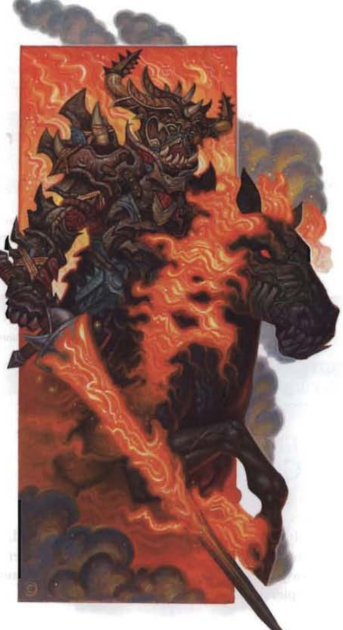
Copyright 2010 Wizards of the Coast This post is part of a series! Click here to see the others.
Death Knights have a long and storied existence in D&D, but this is the first time I hear of Hell Knights.
The Lore
Hell Knights are absolutely not Nazgul, no way, no how. They’re narzugons, which is a completely different thing. Jokes aside, their origins are quite tragic.
The first hell knights used to be servants of He Who Was, the god Asmodeus rebelled against. Asmodeus tricked them into betraying their former master, and their betrayal damned them to serve Asmodeus forever. From that point forward, whenever someone got tricked into betraying their deity, they would become new hell knights upon death.
I think this is the first time I see an explicit mention of people going to Hell and becoming devils in 4e. This used to be a 3e thing, so I guess Hell Knights come from that edition. It could also be that angels and other immortals become hell knights when they get tricked into betraying their deities, if you want to play it that way.
Though hell knights are powerful, becoming one is definitely a form of punishment. A Hell Knight’s existence is an eternity of hatred. They hate themselves for their betrayal, they hate their new masters, they hate their immortality, and they hate free mortals. Though many of them serve Asmodeus directly, every potentate of Hell has at least a few knights at their disposal. The most famous group of them is the Order of the Nightmare, so named for their preferred mounts. Other groups have other mounts, like the mammoth-riding knights of Cania, or the ash riders of Avernus with their wyverns.
Hell Knights usually only associate with members of their own order, but will work together with other devils when commanded to do so.
The Numbers
Hell Knights are Medium Immortal Humanoids (devils), and Level 15 Soldiers with 146 HP. They have Darkvision, are immune to fear, and have Resist 20 Fire. Their ground speed is 6, but they will almost always be mounted on something faster. Their gear is the full “Classic Knight” setup of plate armor, heavy shield, a lance, and a mace.
Their Hell’s Rider trait allows their mount to use the knight’s Athletics, Acrobatics and Stealth scores if they would be better than the mount’s own. The mace does bonus fire damage and knocks prone on a hit, and the lance has better base tamage and crits on a 19-20 when used on a charge. Both count as basic attacks.
As a minor action they can use Eyes of the Narzugon, which causes a creature within 10 squares to be marked and slowed for a turn. This is an effect, so it auto-hits.
Final Impressions
Hell Knights pair really well with Nightmares! As I mentioned in the Nightmare article, enemy riders can still take actions independently of their mounts, so the knights can charge with their lances and maces at the same time their nightmare mounts set the map on fire. Since they have native fire resistance, they can ignore the burning terrain even when unhorsed.
A simple but effective hell knight encounter would consist of three knights and three nightmares, using classic medieval cavalry tactics (charge early, charge often). This group’s lack of ranged attacks would be compensated by the nightmare’s high teleport speed.
-
Let's Read the 4e Monster Manual 3: Devil, Corruption
This post is part of a series! Click here to see the others.
Remember when I told you the MM3 had the very good idea of giving each devil and demon its own entry rather than lumping them all together? Here’s where they kinda toss that out the window and make a big entry full of diverse stat blocks for a single type of devil.
Corruption Devils, or Paeliryons, first appeared in one of the later Monster Manuals for 3rd Edition. I remember they were not very well-received because their lore and appearance had some quite unfortunate implications. This book is still making an effort to make them a big part of the game, so let’s see if the lore improved in any way.
The Lore
The book describes these devils as “bloated infernal masterminds of graft, sleaze, and vice”. They’re better at politics and intrigue than almost anyone else in Hell, and they put that skill to use in subverting mortal societies to their benefit, turning them into decadent kleptocracies via a network of agents and dupes. Most paeliryons work for Dispater, lord of the second layer of Hell, acting as the civil administration of that wretched city.
A corruption devil’s agent network is somewhat inverted from what you’d expect. Its most powerful members are kept at a safe remove from the devil, while those that work directly with it are ignorant sycophants and expendable muscle.
I see that they kept the Paeliryion illustration from the previous edition, but if I’m remembering it correctly the lore was changed to something a little less problematic. With an extra decade of hindsight, I’d probably replace the Ursula cosplay with a big suit and an orange wig.
The Monsters
Corruption Devil
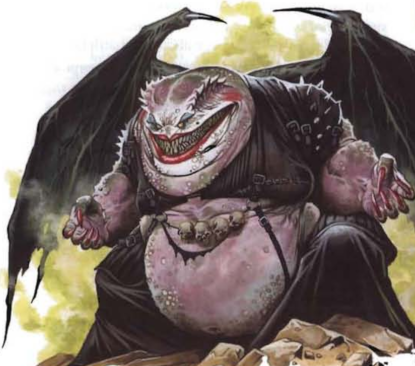
Copyright 2010 Wizards of the Coast The basic model, depicted in the illustration. These are most likely to be found running the city of Dis, but can also go out into the other planes to perform specific missions. Though physically imposing, the creatures prefer to avoid direct conflicts, and will try to negotiate their way out of trouble. If forced into combat they fight like PC bards, staying away from the melee and hurling magically-charged insults and mind control spells at their enemies.
They pal around with other manipulative devils such as succubi, vizier devils, and cambions, though these are almost always pawns rather than full allies. If things see to be going bad for it, the paeliryion will definitely fly away and abandon its “friends”.
Corruption Devils are Large Immortal Humanoids (Devils), and Level 22 Controllers (Leaders) with 208 HP. They have Darkvision and a +5 to save against fear and charm effects. Their ground speed is only 4, but they’re excellent fliers with speed 6 (hover).
These devils project a Corruptive Presence that works as an aura (5) and inflicts a -2 penalty to saves on all enemies inside its radius. It fights in melee with Corrupting Claws and at range with Words of Corruption, both of which deal no immediate damage and instead inflict ongoing psychic damage (save ends).
Their mind control magic takes the form of two minor-action spells. Sway the Corrupt (at-will) targets an enemy that’s taking ongoing psychic damage. It hits automatically, and dominates them for a turn. Doom the Corrupt (recharge 5+) targets an ally or a dominated creature, forcing them to make a melee basic attack against an enemy of the devil’s choice. If that attack hits, its target is also immobilized (save ends).
Finally, it can use Desperate Measures as a minor action to allow an ally to make a basic attack that crits on 19-20, in exchange for the ally granting combat advantage for a turn. This recharges when the devil is first bloodied, and if used while it’s bloodied it applies to every ally within 5 squares instead of just one.
Sire of Corruption
These are the most powerful corruption devils, and among some of the most powerful devils in Hell. They’re the ones who run long term projects of the “turn a whole kingdom to evil” variety, and have a particular strong hatred of “incorruptible” people or institutions, working extra-hard to prove that assertion wrong or destroy these offenders if they can’t. Sires of Corruption can make a particular kind of infernal contract that can make the signing mortal gain power from utterly embracing their vices, thought they still remain pawns of the devil in the end.
These creatures are Medium Immortal Humanoids (devils), and Level 29 Elite Controllers (leaders) with 530 HP. They have 15 fire resistance and a ground speed of 6, but no special senses.
Their Lasting Corruption aura is actually a bit worse than that of a basic corruption devil, since the save penalty only applies to charm effects. All of their non-basic attacks are charm effects, so it doesn’t make a difference to the sire itself, but it’s less helpful to its allies.
Their basic attack is a Corrupting Touch that does a sizable amount of psychic damage and inflicts a -2 penalty to defenses against charm effects for a turn, so you want to alternate it with the other attack: Touch of Vice (recharge 4+), which deals the same amount of psychic damage and inflicts one of six possible effects named after different vices or sins. They’re all (save ends), and have the following effects:
- Lust causes the target to be marked by another enemy within 5 squares.
- Excess dazes.
- Greed slides the target 5 squares to a space adjacent to one of its allies, and forces it to make opportunity attacks against allies whose actions would provoke them.
- Fear pushes the target 5 squares and forbids it from moving closer to the sire of corruption.
- Sloth immobilizes.
- Vengeance auto-damages the target whenever they use an attack power.
The sire chooses which effect happens whenever it hits with Touch of Vice.
But that’s not all! At the start of the fight it can issue a Call to Corruption to summon six Corrupted Followers into the fight, and it can do that again after it’s bloodied! As a minor action it can use Spread Depravity to give one of these servants a free attack.
And finally, when the sire is reduced to 0 HP, it uses a final attack named Lasting Vice, which targets everyone in a Close Burst 5 with a Touch of Vice (same damage, same choice of effects).
These things are nasty, and unlike basic corruption devils they want to get right into the fray while surrounded by their corrupted servants.
Corrupted Followers
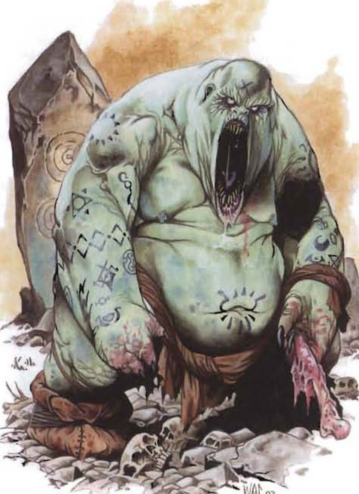
Copyright 2010 Wizards of the Coast 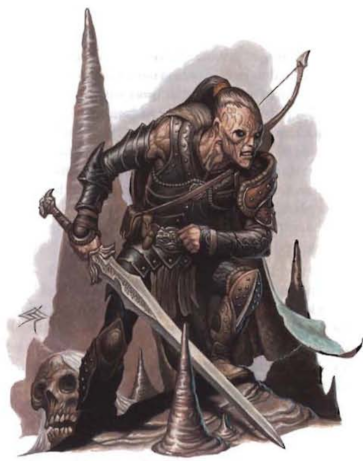
Copyright 2010 Wizards of the Coast 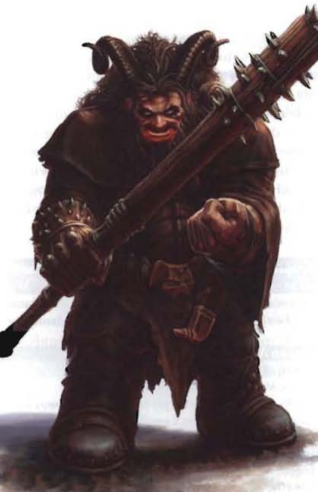
Copyright 2010 Wizards of the Coast These are mortals who were prey to some vice in life, and who were offered a very specific kind of infernal contract in their moment of greatest despair or misery. The contract gives them what they desire, and immediately afterwards turns them into monsters made of the same vice that controlled their mortal lives.
Followers retain no memory of those lives. Left to their own devices, they contrive to spread their ruling vice among the surrounding population. Most often, though, they’re found in the service of their devil master. Usually this is a Sire of Corruption, but it can also be some other powerful devil, or some mortal villain to whom the fiend has loaned them.
Corrupted Followers are epic-tier minions, and there’s a different variety for every vice a Sire of Corruption can generate. It’s entirely appropriate for the Sire’s Call to Corruption power to summon a full sentai team with the six varieties, but you can vary its composition to have simpler combats.
Each Follower type has a touch attack that targets Will and does a bit of damage with a rider, an effect that happens when it dies, and sometimes an aura or passive trait. All of those will be related to each Follower’s Thematic Vice. Here they are:
-
Lust: Corrupted Lechers are Level 24 Minion Lurkers. They can’t be targeted unless they’re the closest enemy to the attacker; their attacks can be melee or ranged, and make the target be marked by another enemy for a turn; when they die, they make their killer move its speed towards another enemy.
-
Excess: Corrupted Gluttons are Level 25 Minion Soldiers that attack with bites that also grab the target. Once they have a target grabbed they can chew on them for automatic damage. When they die, they curse their killer to take damage next turn unless the PC recovers HP in the intervening time.
-
Greed: Corrupted Mongers are Level 26 Minion Artillery. Their melee attacks slide the target adjacent to one of their allies; their ranged attack drain daily or encounter powers from magic items until the end of the encounter! When they die, they cause any daily or encounter powers from the item that killed them to become spent.
-
Sloth: Corrupted Idlers are Level 27 Minion Soldiers. They have a small slowing aura, and their attacks prevent the target from taking move actions for a turn. When they die, they make an attack against the killer’s Will that will knock the PC unconscious for a turn on a hit.
-
Vengeance: Corrupted Lunatics are Level 28 Minion Brutes. Their attacks are weak even for a minion, but force the target to make a basic attack against its nearest ally. If someone misses then with an attack, they can make a free attack against that PC, with the same rider as above. When they die, their killer must again make an attack against an ally. They’re walking Three Stooges skits.
-
Fear: Corrupted Cravens are Level 29 Minion Controllers. When they hit with an attack, they force the target to move its speed away from them. The same happens to their killer when they die.
Final Impressions
I guess I’m still not entirely sold on the whole “Corruption Devil” lore. It feels kinda redundant because this sort of thing was already supposed to be one of the central themes for Hell as a whole. And the stat blocks use the word “Corruption” so much it kinda starts to lose its meaning. The Sire of Corruption seems like it was an entirely different monster that got retrofitted into this entry. It’s obviously inspired by the Seven Deadly Sins, which I feel is kinda played out. But at least it’s all seven in one monster, and it is in-theme for Hell.
Mechanics-wise, the Corruption Devil stat block might work quite well for any bard-type enemies, with a few minor adjustments. The Sire of Corruption is a scary combatant, but its mechanics are extremely tied to the concept of sin so it might be harder to reskin. It would make an excellent basis for an Aspect of Asmodeus, though!
The minions are flavorful, but fiddly. I wouldn’t recommend using the full spread in the same encounter.
-
Let's Read the 4e Monster Manual 3: Derro
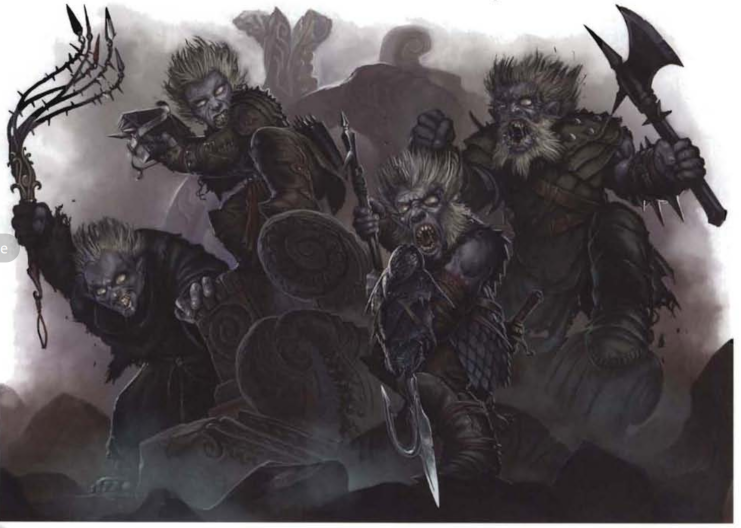
Copyright 2010 Wizards of the Coast This post is part of a series! Click here to see the others.
Derro have been in the game since AD&D 1st Edition, where they appeared in the Monster Manual II. They’re based on the writings of an American author named Richard Sharpe Shaver, who wrote a lot about a civilization of psychic and torture-obsessed underground humanoids he named the dero (from “Detrimental Robots”).
The Lore
D&D Derro have a different origin from Shaver’s dero, though the flavor is quite similar in 4e. When the world was still young, it gave rise to an advanced and power-hungry civilization. Its people, the derro, craved power like that of the primordials, but they wanted to bow to no master. So derro scholars came up with an alternate solution: open a portal to this unoccupied magic-rich dimension they found. There would be no one to contest their claim! Free unlimited power!
They succeeded in opening their portals, but found out this new dimension was far from unoccupied. It was the place known today as the Far Realm. After the derro beheld what came through to greet them, they suddenly realized they had finally found a master worth worshiping. In other words, their sanity was blasted to dust.
Derro civilization became so horrifying in its depravity that the World Serpent, one of the most powerful primal spirits, coiled around it and dragged the entire thing underground. This stopped their grand machinations but did not destroy them. Many centuries later, a drow expedition found the ruins of the derro empire, and what the derro became in the dark. Only one of their number made it home… mostly. Her report convinced the drow these maniacs must be eradicated, but this is harder than it looks.
In our narrative present, derro live in small groups that crawl around the ruins of their old cities, and worship the energies and beings of the Far Realm. They’re enthusiastic slavers, going on frequent raids to the surface or to other Underdark communities to find new captives. They treat these slaves badly, torturing them for fun and killing them for the smallest of offenses. The slaves, in turn, will turn on their captors as soon as the smallest chance to escape presents itself.
Derro are only capable of making true alliances with beings from the Far Realm, suck as grells, mind flayers, and aboleths (whom they sometimes worship). They despise everyone else, and everyone else hates them right back.
The Monsters
Derro are statted up as mid-Paragon threats, suitable for inclusion in encounter groups that feature their preferred allies listed above. The entry also gives enough Derro stat blocks to make decent all-Derro encounters.
Derro are Small Aberrant Humanoids. They have Darkvision, and their signature ability is named Strength of Madness. It’s an encounter power that lets them roll a d6 and add the result to all of their attack rolls until the end of their next turn, but also makes them grant combat advantage during this time.
Derro Warrior
Combatants like these typically make up the patrols that keep derro territory “secure” by engaging in preemptive attacks against its neighbors. Gotta keep them guessing, y’know.
Warriors are Level 13 Artillery with 101 HP and all standard Derro traits. Their speed is 5, and they have a +2 to saves against fear effects. They carry daggers and a repeating hand crossbows with several magazines.
The dagger is their default melee attack, and they can fire the Repeating Hand Crossbow as a minor action, or use a standard action to let loose a Bolt Spray (recharge 5+) that hits a Close Blast 5 for heavy damage and pushes 1 square on a hit. Any of these will deal extra damage against targets granting combat advantage.
Bolt Spray is not selective, and most derro warriors don’t particularly care if their allies are caught in its area of effect. They’ll use it whenever possible.
Derro Thug
This can be a less capable warrior, or just your average civilian psychopath. Derro thugs are Level 14 Minion Brutes and they fight with clubs. Their only special ability is Mad Sacrifice: when the thug misses an attack, it can sacrifice itself to turn the miss into a hit.
Using them in combat is simple: get a whole bunch of them to charge the PCs and hit whoever’s closest, using Mad Sacrifice liberally.
Derro Fanatic
Warriors that display notable skill and potential are invited by Derro savants to peer directly into the Far Realm. Those who remain functional after the experience use this stat block.
Fanatics are Level 14 Skirmishers with 140 HP. They carry battleaxes into combat. Their basic axe attack has an attached effect that allows them to end any mark on themselves and shift 2 squares before making the attack roll.
If they bloody an enemy, their Insane Bloodlust allows them to immediately make another attack against that same enemy. And while a fanatic is themselves bloodied, Unleashed Madness gives them a -2 attack penalty and 2d6 bonus damage.
That effect on their basic attack allows them to slip right past the party’s front line and go for the squishies, and by the time they get there they might even have turned into mini-brutes. Fanatics always fight to the death.
Derro Harvester
This derro is specialized in capturing slaves, a very important function in derro society. They always need more people to do the labor derro consider beneath themselves, and to act as experimental subjects.
Harvesters are Level 15 Lurkers with 116 HP. They wield war picks and carry a set of shackles. Their attacks do bonus damage if the target is granting them combat advantage.
Their basic attack is a strike with the pick and has no special effects, but they have a frightening power named Harvest. To use it, the derro must have started its turn hidden from the target. It’s an attack against Fortitude, which does no damage but knocks the target unconscious (save ends).
The harvester can them use its shackles to bind the helpless victim, which from that point on is restrained and falls prone whenever it’s hit with a melee attack. The victim can try to escape by succeeding in an escape action against the harvester (Athletics vs. Fort 27, or Acrobatics vs. Ref 28).
If Harvest fails or a victim gets loose, the derro can use Flee to the Shadows, which allows it to move its full speed and make a Stealth test to hide if it has concealment at the end of the movement.
The shackles can only be used once per encounter, but Harvest is at-will. So a harvester could knock someone out, shackle them, and have its buddies drag the victim to their base, keeping them unconscious with multiple applications of Harvest. I guess that once they’re no longer using combat turns, the victim just stays down until they wake up in a cell.
Derro Ironguard
Ironguards are more disciplined than your typical derro warrior, which admittedly is not a high bar to clear. They are proficient in the use of hooked spears, and are often employed to catch runaway slaves or guard them so they don’t run away in the first place. Paranoid derro bigwigs (i.e, all of them) also hire ironguards to watch their stuff.
Ironguards are Level 15 Soldiers with 150 HP. Their hooked spears deal extra damage against prone targets, so they love stabbing people when they’re down. The weapons are also used in hooking jabs attacks, which deal damage and grab on a hit, and on non-damaging unbalancing thrusts (minor actions) which target a grabbed creature and knock them prone on a hit.
Their tactics are obvious from the ability descriptions: Hooking Jab; Unbalancing Thrust; stabstabstabstab. Send your beefy defenders to fight them, because Unbalancing Thrust targets Fortitude.
Derro Savant
Our spellcasters, or more precisely psions. They preserve the old lore that gave the original derro access to the Far Realm, and spend their time deep inside the ruins of their empire trying to find ways to reopen the old portals. They wield scourges in combat, and use orbs as their implements.
Savants are Level 16 Controllers with 154 HP. They have a ground speed of 5 and a teleport speed of 3. Their scourges damage and inflict a -2 attack penalty for a turn. Their basic ranged attack is Mind Scourge, which deals psychic damage and forces the target to choose between taking 10 ongoing psychic damage or being dazed. The chosen condition is (save ends) either way.
The savant can also open a mini-portal to the Far Realm with the Window to Madness power. This creates a small zone (area burst 1) centered on an ally within 10 squares. The zone lasts until the end of the encounter, and any non-derro that enter the zone or ends their turn there take 10 psychic damage. The savant can end the zone early with a minor action, in which case the power recharges. It can also slide every creature inside the zone 2 squares as a minor action.
Warped Slave
This is not a derro, but a slave that was subject to their experiments and warped into a tentacled abomination. The stats could also be used for a generic Thing From Beyond summoned from a derro portal or other Far Realm opening.
These unfortunates are Large Aberrant Humanoids and Level 16 Brutes with 193 HP. They have Speed 6 but can’t shift, and they have Darkvision.
The warped slave’s Disintegrating Mind works as an aura (1), which deals psychic damage to enemies caught inside. If a derro inside the aura uses its Strength of Madness ability, the slave gets to make a free tentacle attack.
This thing can Bite or use Tentacles to fight. The tentacles grab and pull the target 1 square in addition to dealing damage. When bloodied, it gets desperate and gains a Flailing Tentacles attack that affects all enemies in a Close Burst 2, damaging and pulling them 1 square on a hit.
Warped Slaves follow the orders of their derro masters, or rampage about the battlefield trying to attack the nearest enemies. It often amounts to the same thing.
Final Impressions
The whole “Shaver Mysteries” horrific underground humanoid vibe is quite evocative, and judged on that merit alone I’d rate the derro very highly as RPG monsters. However, in the context of D&D they end up being just one more species of evil Underdark dwellers who like slavery and torture, this time in size Small. If I include derro in a game, I’m probably removing at least one of the others, and maybe more.
Mechanically they’re okay, and you have enough here to make a whole derro-themed dungeon. For spice, you could add aboleth leaders and mind flayer allies.
subscribe via RSS